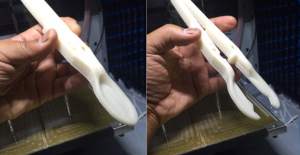Thanks to the aptly named 3D printing company Made in Space, the International Space Station (ISS) is now equipped with a fully functioning zero gravity 3D printer. In order to put the printer to its best use a competition was created to spur creativity and innovation for 3D printing in space. There were 244 submissions to the competition, most of which being simple tools to aid space life such as a clever spoon which could also split into a pair of tongs (pictured below).
Canadian astronaut Chris Hadfield and Grant Imahara, of TV show Mythbusters, announced the winner earlier this week. Imahara recently helped unveil Local Motors’ new developments with their 3D printed car, while Chris Hadfield was a commander on the Space Station in 2013 meaning the two were worthy judges. The competition winner was Andy Filo with his ingenious 3D printed device that will fling Femtosatellites into space. Femtosatellites are very small devices that can be used to monitor and collect data in space. The satellites are very clever despite their small size and can work in clusters together. Filo’s device means these satellites now have a 3D printable means of being distributed into space in order to do their work.
Imahara exclaimed his excitement with the device:
One of the most important issues [regarding] the femtosatellites is that they need to be deployed in a specific pattern. This box, it’s incredible, it looks very simple and can be entirely 3D printed, it makes it easy to assemble all the satellites in it—that makes it all possible.

There was also another submission of a vice-like object which would help combat zero gravity by clasping things in place. These were all clever tools, particularly when one realizes the usual difficulty associated with acquiring tools in space and considering the difficulty of living without gravity. Hadfield explained these issues as he says; “you’re constantly looking for a clamp or the right velcro location, or the right bungee to hold things in place. A couple of the final designs were addressing that issue.” The 3D printer eliminates such trouble and furthermore enables the astronauts to print on-demand if they run out of tools.
This competition, and the innovation behind the winning entry, shows the extent to which 3D printing is pushing the boundaries of creativity. For Hadfield, this competition has raised the bar for 3D printing designs:
Challenge people to come up with stuff, recognize that the technology is new, but use that as the new benchmark and go from there
Featured image shows Grant Imahara and winner Andy Filo. Image via TechCrunch


